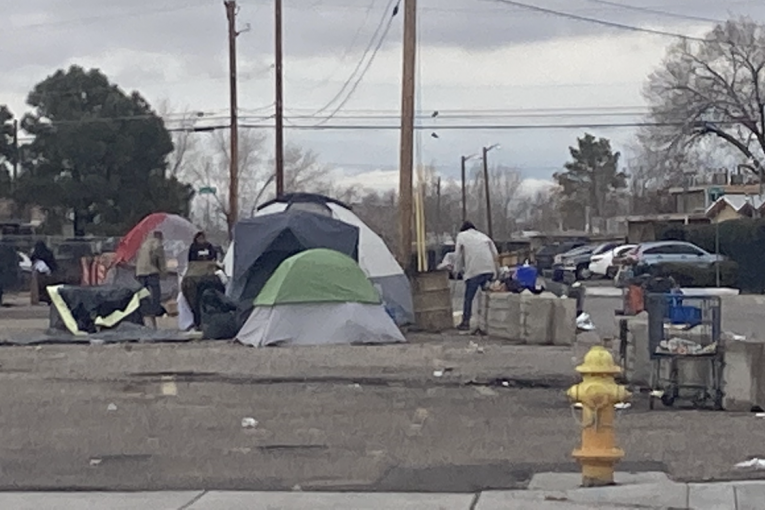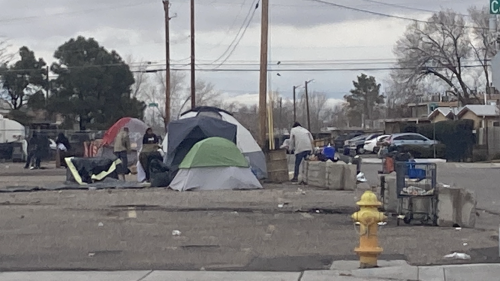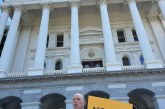

![]()
Photo Attribution: Cyanidethistles, CC BY-SA 4.0 <https://creativecommons.org/licenses/by-sa/4.0>, via Wikimedia Commons
By Sheila Teker
Since the beginning of 2023, California has been hit by unusually severe weather, which has put individuals vulnerable to natural disasters, such as the homeless, at major risk.
Starting late December 2022 to early January 2023, California has experienced nine “atmospheric rivers”, resulting in a “record amount of rain and mountain snow [that hit] California particularly hard”—and weather conditions are continuing to degrade. On February 24, temperatures in the San Francisco area dropped to 39 degrees, “setting the record for the lowest temperature recorded on ant Feb. 24” in the area, and continues to experience unusually lower temperatures and winter storms, according to National Weather Service Meteorologist Jeff Lorber.
While much news coverage has captured the consequences of such weather events, including flooding, sinkholes, landslides, and destruction of infrastructure, comparatively less attention has been brought to the devastating effects on unhoused populations in California.
According to the 2022 Annual Homelessness Assessment Report (AHAR) to Congress, more than half of all people experiencing homelessness in the US are concentrated in 4 states; the highest rate of those 4 is California at 30%, or more than 170,000 people. Of every 10,000 people in California, 44 experience homelessness; and 67%—at least 115,000—of those unhoused experience it outside, without shelter. These individuals sleep in tents, vehicles, or public open spaces, increasing their vulnerability to severe weather conditions. The damages to their limited housing modes, especially encampments, are injurious, if not fatal. Many of these locations have experienced extreme flooding and falling trees, exacerbating their already unstable living conditions, including the inaccessibility of drinking water, electricity, and other basic necessities.
As for the encampments that are still standing from before or after the initial storms, San Francisco in particular has continued carrying out encampment sweeps, despite court orders in late 2022 resulting from unhoused individuals and the Coalition on Homelessness taking legal action against it.
To alleviate the significant challenges and even deaths these unhoused populations have experienced—and will continue to experience as California deals with extreme weather events— many counties have attempted to provide shelter and/or advise encampments to move elsewhere for safety concerns. Officials in the city of Ontario, east of Los Angeles, “offered hotel vouchers to unhoused people”, and Sacramento “sent outreach workers to encampments to advise unhoused people to move their tents away from…risk of flooding and is providing free transportation to the warming centers it has opened.” Similar efforts in opening up warming centers and more shelter spaces have been made in Southern California, which is predicted to be the most affected by incoming winter storms. However, according to Bob Erlenbusch, executive director of the Sacramento Regional Coalition to End Homelessness, “Local Shelters and warming centers don’t always accommodate the needs of homeless people…[as] people have to leave their belongings behind…[while] others don’t know about the centers, or don’t have a way to get there.”
Many other cities have been reported to have neglected providing aid at all.
In Berkeley, the lack of accommodations for the unhoused population has been crippling. According to @peoplesparkberkeley, “during the level 5 storm the governor declared a state of emergency, but the city of Berkeley failed to make a single 24 hour emergency warming center.” The one warming shelter available was only open until 6 in the morning, which “meant that people seeking shelter there were woken up at 5 am. and kicked out by 6 am.”, regardless of health status and age.“With the ongoing rain…uhoused community members were cold and wet for way too long without a way to get dry and warm,” stated @peoplesparkberkeley. Those who sought shelter elsewhere “huddled outside a closed shelter under the canopy”, but were said to have “had the cops called on them.”
At the time, the city council was on vacation, and there was “no one to answer…emails or take any sort of accountability.” In regards to providing an appropriate space for setting up shelter, the University canceled on them “several times”—but once debris and machinery were removed from the basketball courts, volunteers brought together resources to set up temporary shelters, managing them for 6 days with the money they had fundraised for the park.
As weather conditions continue to fluctuate, it is a concern among many as to whether public officials will be more involved in the effort to provide essential materials and safety for unhoused individuals, or if many areas—like Berkeley—will continue to experience a lack of consideration and preparedness for such events.
Sheila Teker is a writer for the Vanguard at Berkeley’s Social Justice Desk




